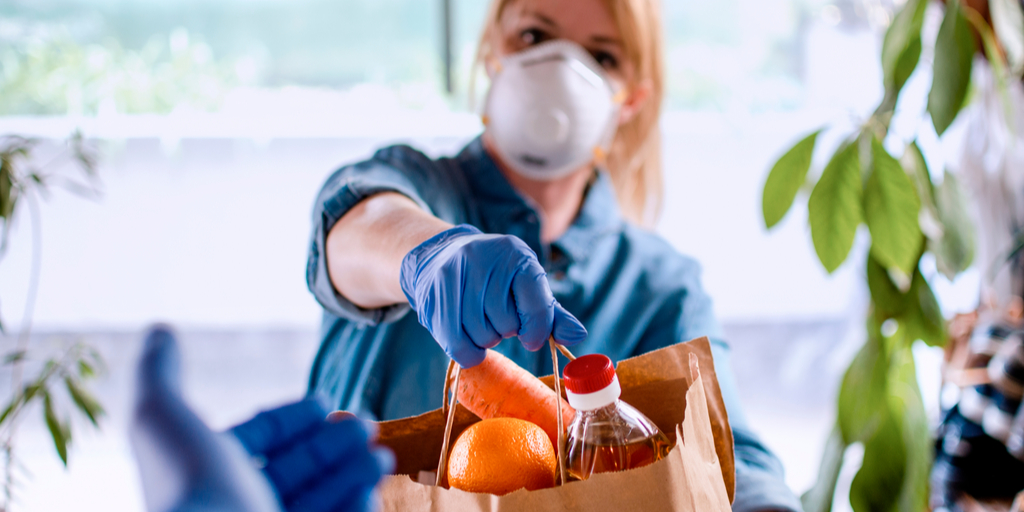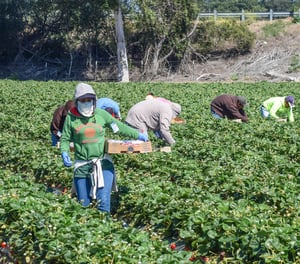
Last week I ventured out into our virus-plagued world and actually got on an airplane. It’s been months since I’ve done that. The airport was empty, from the closure of my favorite economy parking lot to the lack of traffic and endless closed restaurant venues. Getting to the airport early was my way to regroup, punch out some emails and have a glass of wine, but not anymore. In today’s environment, you will zip in with no traffic, pay a higher rate for parking, put on your mask and politely sit in silence as you wait for your plane. Oh yes, bring your mask too, as it is now required and, unlike mine, make sure it is comfortable to wear all day! My ears are still hurting from the chaffing straps.
The fresh food supply chain is going through tremendous upheaval too. We’re all wondering if we’ll ever get back to normal, but it doesn’t seem like it will be anytime soon.
I recently read a good article from McKinsey calling out some of the disruptions they’re seeing and projecting out an altered view of the future. A future that will benefit some but hurt others.
 The good news here is that everyone eats. At least the food economy has that going for it. But the landscape has changed drastically from supplier to processor, retailer to restaurant operator. The systems and assumptions we use throughout our supply chain must be flexible enough to shift into different markets, different supply chain models. Supply chain costs must be kept efficient as well. When supply stability goes, so does price stability. Efficiency and cost containment are the name of the game in these trying times.
The good news here is that everyone eats. At least the food economy has that going for it. But the landscape has changed drastically from supplier to processor, retailer to restaurant operator. The systems and assumptions we use throughout our supply chain must be flexible enough to shift into different markets, different supply chain models. Supply chain costs must be kept efficient as well. When supply stability goes, so does price stability. Efficiency and cost containment are the name of the game in these trying times.
Here are some highlights from the article that caught my eye:
… physical distancing and associated lockdowns have dramatically reversed the trend of consumer spending on food. Consumers, forgoing public venues and eating at home, stocked up on groceries and supplies, boosting sales for the month by 29 percent over the prior year. Meanwhile, sales declined at restaurants, fast-food locations, coffee venues, and casual-dining locations by 27 percent.
Food sources tied to a particular supply chain and customer base been altered to find new markets, convert to other outlets or simply be disband. I think about my friends in the potato industry where French fries are often staple of popular fast-food dining. But how many, now cooking from home, are making fries? Potato varieties planted months ago must simply be disregarded as neither the packaging nor the delivery mechanisms can handle the shift from food service to retail.
The pandemic has also had an impact on labor.
Within the United States, multiple farming and processing value chains are dependent on migrant workers, including those under sponsored visa programs. Only three in ten workers in the US agricultural workforce are born in or are citizens of the United States; the rest are born in other countries, and many are in the United States on guest agricultural visas. If concerns related to the COVID-19 pandemic persist, it may be challenging to find workers, even at a premium, as people avoid close-quarters activities and limit their own exposure risk.
 In the West, the workforce for agricultural crops is largely Hispanic, often living in multi-generational housing arrangements. The virus has found its way into these homes, putting our limited workforce at more risk. Prior to the pandemic, strawberry growers were already facing labor shortages. Production is now limited by labor, not growth. Berries have had to stay in the fields and rot as there simply aren’t enough workers to go around. Mechanization of these practices cannot come fast enough as we struggle with the increased demands for labor.
In the West, the workforce for agricultural crops is largely Hispanic, often living in multi-generational housing arrangements. The virus has found its way into these homes, putting our limited workforce at more risk. Prior to the pandemic, strawberry growers were already facing labor shortages. Production is now limited by labor, not growth. Berries have had to stay in the fields and rot as there simply aren’t enough workers to go around. Mechanization of these practices cannot come fast enough as we struggle with the increased demands for labor.
With the food service sector immediately coming to a halt, McKinsey further states that shifts in the distribution channel have caused logistical bottlenecks and storage shortages as distributors cancel orders.
Distributors have been significantly affected by quick-service and casual-dining restaurants in their switch to takeout only, with slow recovery given the staged return to full service.
The bright spot here may be in with grocery retailers. Demand from shoppers has increased but so has the demand for home delivery mechanisms. The retailers that have already made the investment in home delivery infrastructure are faring the best, as there are new pressures on the processes and resources necessary to make it all happen.
In my house we’ve mostly switched to home delivery and, quite frankly, are enjoying it. But I have to admit, we often get mis-matched orders and our orders are not always filled correctly. Being in the business, we certainly are forgiving, but the stories about customer service gaps or even porch pirates have put new operating rules in place for consumers like us.
Given fixed prices and cost-driven margin compression in retailer value chains, the returns on investment may not exist for farmers, producers, distributors, and retailers to make medium-term investments to address channel mismatches via investments and rebalancing.
Picking up on this McKinsey point, I suspect we’ll see M&A activity continue as some companies in this space simply opt out or can’t sustain themselves for the full recovery. A return to normalcy doesn’t seem to be coming anytime soon. Pockets of outbreaks continue to keep local health officials on edge. For us in the supply chain, look for ways to drive efficiency, dump costly systems and embrace the new norm of digital business practices.
I think the internet and efficient buying/selling are more important than ever before, whether you’re buying truckloads, cases or one head of cauliflower at a time. Technology, always a pathway for more efficient and better managed processes, is more critical now than ever before.
Now if someone could just apply that technology to developing a more comfortable mask!
Lorem ipsum dolor sit amet, consectetur adipiscing elit

These Stories on Coronavirus
Procurant USA LLC
475 Alberto Way - Suite 230
Los Gatos, CA 95032
1-669-221-1026
info@procurant.com
